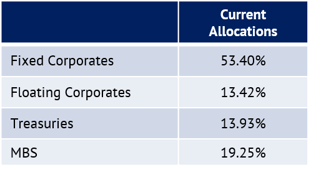In a choppy quarter marked by large moves within a defined trading range, the Theta Income Strategy was able to generate a net return of 1.26% for the quarter, bringing the YTD net return to 5.31%. On a longer-term basis, the Theta Income Strategy has the ability to generate attractive absolute and risk-adjusted returns relative to bonds partially due to focus on risk control and volatility mitigation in the Strategy. The volatility relationship between the Strategy and bonds continues to trend very favorably so far in 2019. From the start of the year through 9/30/19, the annualized standard deviation of the daily returns of Theta Income has been only 2.06% compared to 3.30% for the Bloomberg Barclay’s US Aggregate Bond Index. These results are supportive of our ongoing effort to generate the highest returns per unit of risk.
After reaching a new all-time high in July, the S&P 500 Index sold off sharply at the beginning of August on a combination of US/China trade tensions and overall economic concerns. This selloff coincided with a temporary inversion of the yield curve, which has historically been a precursor of a future recession. Equity and bond markets became even more sensitive to daily trade policy updates, economic news, interest rate moves and FOMC speculation. When all of the dust settled, the S&P 500 Index finished up 1.70% after wildly moving around a 7% trading range between 2825 and 3025. The Volatility Risk Premium, the key measure of how overpriced options are and an important tailwind to the Strategy, continues to trend favorably. After a poor year for this risk premium in 2018, the Volatility Risk Premium has returned to more normal levels and has now been positive in all three quarters for the year.
Coming into the final quarter of the year, the market is still faced with all of the same concerns. With softening economic data and questions about the impact the Fed might have with interest rate policy should a slowdown continue, increased focus is on the US/China trade situation. A deterioration in trade talks would put further pressure on global economies and business/consumer sentiment, while any reduction or postponement in tariffs could spur renewed optimism that growth can return. The outcome of the upcoming US/China trade meetings in Washington might be the key to which way the market breaks out of the current trading range. Regardless of the outcome of those meetings and the short-term reaction of the equity markets, long-term equity volatility should continue to trend higher as we move towards the end of this business cycle. The 4th quarter will present investors with a number of potential volatility catalysts beyond just US/China trade, including a critical earnings season, two FOMC meetings, highly scrutinized economic reports, Brexit risk and European recession risk (investors will be highly sensitive to German data). With this backdrop, as well as the fact that equity volatility tends to be highest from early September to Thanksgiving, it is reasonable to expect at least one more wave of volatility between now and the end of the 4th quarter. By the end of the year, a much clearer picture of the state of the economy should emerge.
The FOMC followed through with an abrupt change in their stance from the beginning of the year with two rate cuts during the third quarter. Investors continued facing mounting uncertainties, providing a supportive backdrop for high quality bonds. The Theta Income’s bond portfolio contributed positively to returns for the quarter given this tailwind, albeit not to the same magnitude as the Bloomberg Barclays Aggregate Bond Index, due to the shorter duration approach taken in the Strategy. With the continued inversion of the yield curve on the short end, the risk profile of the market continues to support a short duration approach. The positioning also supports our efforts to position the portfolio for the highest return per unit of risk.
Following is a breakdown of the composition of the bond segment of the Theta Income Strategy as of 9/30/2019:


We are pleased to announce that the highly risk-controlled option writing overlay utilized in the Theta Income Strategy is now available through Overlay Shares, in which the overlay is combined with five separate underlying beta sources: U.S. Large Cap Equity; U.S. Small Cap Equity; Non-U.S. Equity; Core Bond and Municipal Bond. This new suite of solutions gives advisors and their clients greater flexibility in accessing the benefits of our overlay.
As always, we appreciate your continued support and interest.
Learn more about Liquid Strategies and our process in our most recent White Papers...
Important Disclosures
Past performance is no indication of future results. Inherent in any investment is the potential for loss. The adviser may not achieve the stated annual return objective. This commentary is not meant as a general guide to investing, nor as a source of any specific investment recommendations. This commentary makes no implied nor express recommendations concerning the manner in which any client’s accounts should or would be handled.
With regard to indices presented herein, please note the volatility of the indices may be materially different from the individual performance attained by a specific investor. In addition, the portfolio’s holdings may differ significantly from the securities that comprise the indices. The indices have not been selected to represent an appropriate benchmark to compare an investor’s performance, but rather are disclosed to allow for comparison of the investor’s performance to that of certain well-known and widely recognized indices. You cannot invest directly in an index.
Performance is presented net of fees and was calculated using standard management fees of 1.00% annually. For further details on fees, please refer to Part 2A of Adviser’s Form ADV. Inherent in any investment is the potential for loss. Past performance results are not necessarily indicative of future performance results.
The account’s performance has been compared to the following indices. Index returns illustrated would be lower if transaction costs and fees for asset management were deducted. Information regarding the index contained in this report is from sources deemed to be reliable however; the Adviser does not guarantee the accuracy or completeness of such information.
The investments and services to which this presentation relates are only available to persons with a categorization as a qualified client, as defined under Rule 205-3 of the Investment Adviser Act of 1940, and other persons should not act or rely on it.
S&P 500 Total Return Index - An index of 500 stocks chosen for market size, liquidity and industry grouping, among other factors. The S&P 500 is designed to be a leading indicator of U.S. equities and is meant to reflect the risk/return characteristics of large cap stocks. All cash distributions (e.g. dividends and income) are reinvested. Used as a proxy for "Stocks" above.
Barclay’s U.S. Aggregate Bond Index - A broad-based index of bond securities used to represent investment-grade bonds traded in the U.S. The index was formerly known as the “Lehman Aggregate Bond Index”. Used as a proxy for "Bonds" above.
CBOE Volatility Index ("VIX") - An index sponsored by the Chicago Board of Options Exchange (CBOE) that shows the market's expectation of 30-day volatility. It is constructed using the implied volatilities of various option expirations and various strike prices of S&P 500 index options.
Correlation (R2) - A statistical measure of how two financial instruments (e.g. securities, indices, etc.) move in relation to each other. A correlation of +1 implies that as one security moves, either up or down, the other security will move in lockstep, in the same direction. Alternatively, the closer correlation is to 0, the less the movements of two securities are related to one another.
Beta - A measure of the portfolio’s sensitivity to changes in the benchmark. A beta of 1 indicates the portfolio has historically moved with the benchmark. A portfolio beta greater than 1 indicates the portfolio has been more volatile than the benchmark and a portfolio beta less than one indicates the portfolio has been less volatile than the benchmark. Beta in this presentation is calculated using monthly historical returns.
Sharpe Ratio - A measure for calculating risk-adjusted return. The Sharpe ratio is the average return earned in excess of the risk-free rate per unit of volatility or total risk. Subtracting the risk-free rate from the mean return, the performance associated with risk-taking activities can be isolated. Sharpe ratio = (Mean portfolio return − Risk-free rate)/Standard deviation of portfolio return. For Sharpe Ratio calculations in this presentation, the “risk free rate” is represented by the annualized monthly returns of the 3 Month US T-Bill.
Max Drawdown - A measure of the largest single drop from peak to trough based on monthly portfolio returns
HFRX Absolute Return Index - A stock index designed to measure absolute returns. The absolute return index is actually a composite index made up of five other indexes. This index is used to compare the absolute returns posted by the hedge fund market as a whole against individual hedge funds.
Standard Deviation - A measure of the dispersion of a set of data from its mean.



